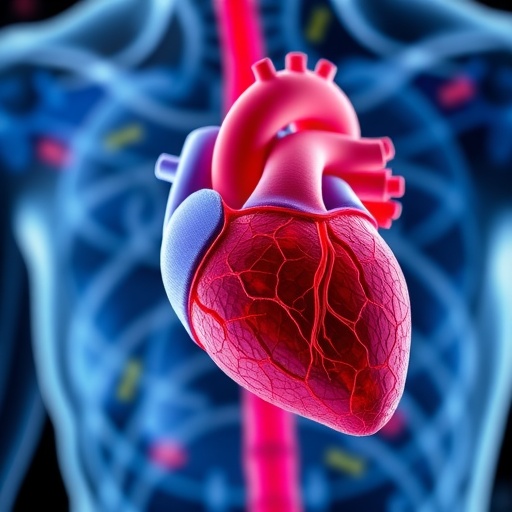
Infective endocarditis (IE) stands as one of the most formidable challenges in modern cardiology, largely due to its elusive early symptoms and devastating complications. A groundbreaking study recently published in Nature Communications by He, Hu, Zhu, and colleagues presents a monumental stride toward unraveling the complexity of IE through integrated plasma and vegetation proteomics. This innovative approach paves the way for earlier diagnosis and potential tailored treatments, marking a paradigm shift in how clinicians may eventually combat this life-threatening condition.
Infective endocarditis is an inflammation of the endothelial lining of the heart, primarily involving the heart valves, precipitated by microbial infection. Despite advances in antimicrobial therapy and cardiovascular care, mortality rates remain troublingly high, largely due to delayed diagnosis and the intricate pathogenic mechanisms that have long evaded comprehensive understanding. The research group employed a proteomic lens—essentially a large-scale study of proteins expressed in biological samples—to dissect the molecular underpinnings of IE both in the bloodstream and within the vegetations, the hallmark infectious masses on heart valves.
The key innovation here is the simultaneous analysis of plasma, the liquid component of blood containing numerous proteins, and excised vegetations, complex biofilms consisting of bacterial colonies enmeshed within host proteins and immune factors. This dual-pronged proteomic characterization enabled the identification of distinct protein signatures linked to infection severity and immune response. Unlike previous single-source analyses, this integrated strategy unveils the dynamic crosstalk between circulating proteins and the localized pathological environment of the heart, revealing a more comprehensive picture of disease progression.
.adsslot_B2fGzwoQA6{width:728px !important;height:90px !important;}
@media(max-width:1199px){ .adsslot_B2fGzwoQA6{width:468px !important;height:60px !important;}
}
@media(max-width:767px){ .adsslot_B2fGzwoQA6{width:320px !important;height:50px !important;}
}
ADVERTISEMENT
Using advanced mass spectrometry techniques, the team quantified thousands of proteins, rigorously comparing their abundance and interaction patterns in samples derived from IE patients against healthy controls. Among their remarkable findings was the identification of inflammation-related proteins and immune modulators that are substantially elevated in plasma during early infection stages. These biomarkers hold immense potential not only as diagnostic tools but also as guides to the molecular pathways hijacked by pathogens, offering new therapeutic targets.
Moreover, the proteomic landscape of vegetations revealed a predominantly host-driven response interwoven with microbial proteins, underscoring the complexity of the infective nidus. The presence of specific bacterial proteins within these vegetations, in conjunction with host immune factors, provides insight into how pathogens evade immune surveillance and persist despite surgical and antibiotic intervention. This knowledge is crucial because it directly informs the development of targeted therapies aimed at disrupting these protective microbial niches.
The study also breaks new ground by demonstrating how dynamic changes in plasma proteomics can reflect the evolving state of infection. Tracking these fluctuations enables clinicians to monitor disease progression or regression in real-time, potentially improving patient stratification and optimizing therapeutic regimens. This real-time monitoring capability could revolutionize clinical management by shifting from reactive to proactive treatment paradigms.
Another intriguing aspect of the work is the integration of bioinformatics analyses to interpret the vast proteomic datasets, employing network modeling to pinpoint critical nodes and hubs in the molecular interactions governing IE pathology. These computational insights elucidate the regulatory circuits that orchestrate the host-pathogen battle, shedding light on how certain proteins may amplify or mitigate inflammation and tissue damage.
The translational implications of this research are expansive. Early and accurate diagnosis has long been the Achilles’ heel of IE management; many patients suffer irreversible cardiac damage before the infection is confirmed. Proteomic biomarkers identified in plasma might soon be developed into minimally invasive blood tests, enabling clinicians to detect IE at its inception. Such diagnostic advancements would lead to earlier intervention and improved prognosis, reducing the need for aggressive surgical procedures.
Furthermore, understanding the proteomic milieu of vegetations opens new therapeutic avenues. By targeting specific proteins crucial for biofilm formation and pathogen survival, it may be possible to disrupt these infectious aggregates, enhancing antibiotic efficacy and reducing relapse rates. This approach aligns with the broader trend in infectious disease research toward precision medicine, where treatments are tailored to the molecular characteristics of individual infections.
The authors emphasize that while these findings are highly promising, further studies involving larger, diverse patient cohorts and longitudinal sampling are essential to validate these biomarkers and translate them into clinical practice. Additionally, cross-disciplinary collaboration between proteomics experts, cardiologists, microbiologists, and bioinformaticians remains vital to harness the full potential of these integrated analyses.
Notably, this research also highlights the power of proteomics as a systems biology tool, transcending IE and potentially informing investigations into other cardiovascular infections and inflammatory disorders. By comprehensively charting protein expression and interaction networks in disease contexts, researchers can uncover hidden mechanisms and therapeutic targets that traditional genomic or transcriptomic studies might miss.
In summary, the integrated plasma and vegetation proteomic characterization pioneered by He and colleagues represents a landmark achievement in the quest to conquer infective endocarditis. Their meticulous work offers unprecedented molecular insights into the pathogenesis of IE, opening doors for earlier diagnosis, improved monitoring, and novel treatment strategies. It is a testament to the transformative power of interdisciplinary research in addressing some of the most complex challenges in medicine today.
As this research moves forward, it holds the promise not only of saving lives but also of inspiring a new generation of diagnostic and therapeutic innovations. The convergence of proteomic technologies, computational analytics, and clinical application heralds a future where infections like IE may be caught in their nascent stages and defeated before catastrophic damage ensues. This study thus stands as a beacon of progress, illuminating the path toward more precise, effective cardiovascular care.
Subject of Research: Proteomic characterization of infective endocarditis through integrated plasma and vegetation protein analysis for early diagnosis and treatment.
Article Title: Integrated plasma and vegetation proteomic characterization of infective endocarditis for early diagnosis and treatment.
Article References:
He, S., Hu, X., Zhu, J. et al. Integrated plasma and vegetation proteomic characterization of infective endocarditis for early diagnosis and treatment. Nat Commun 16, 5052 (2025). https://doi.org/10.1038/s41467-025-60184-8
Image Credits: AI Generated
Tags: advancements in cardiovascular carechallenges in diagnosing infective endocarditisearly detection of heart infectionshigh mortality rates in heart infectionsinfective endocarditis diagnosisInnovative Approaches to Heart Diseasemicrobial infection of heart valvesmolecular mechanisms of infective endocarditisNature Communications study on endocarditisplasma and vegetation proteomicsproteomic analysis in cardiologytailored treatments for infective endocarditis





